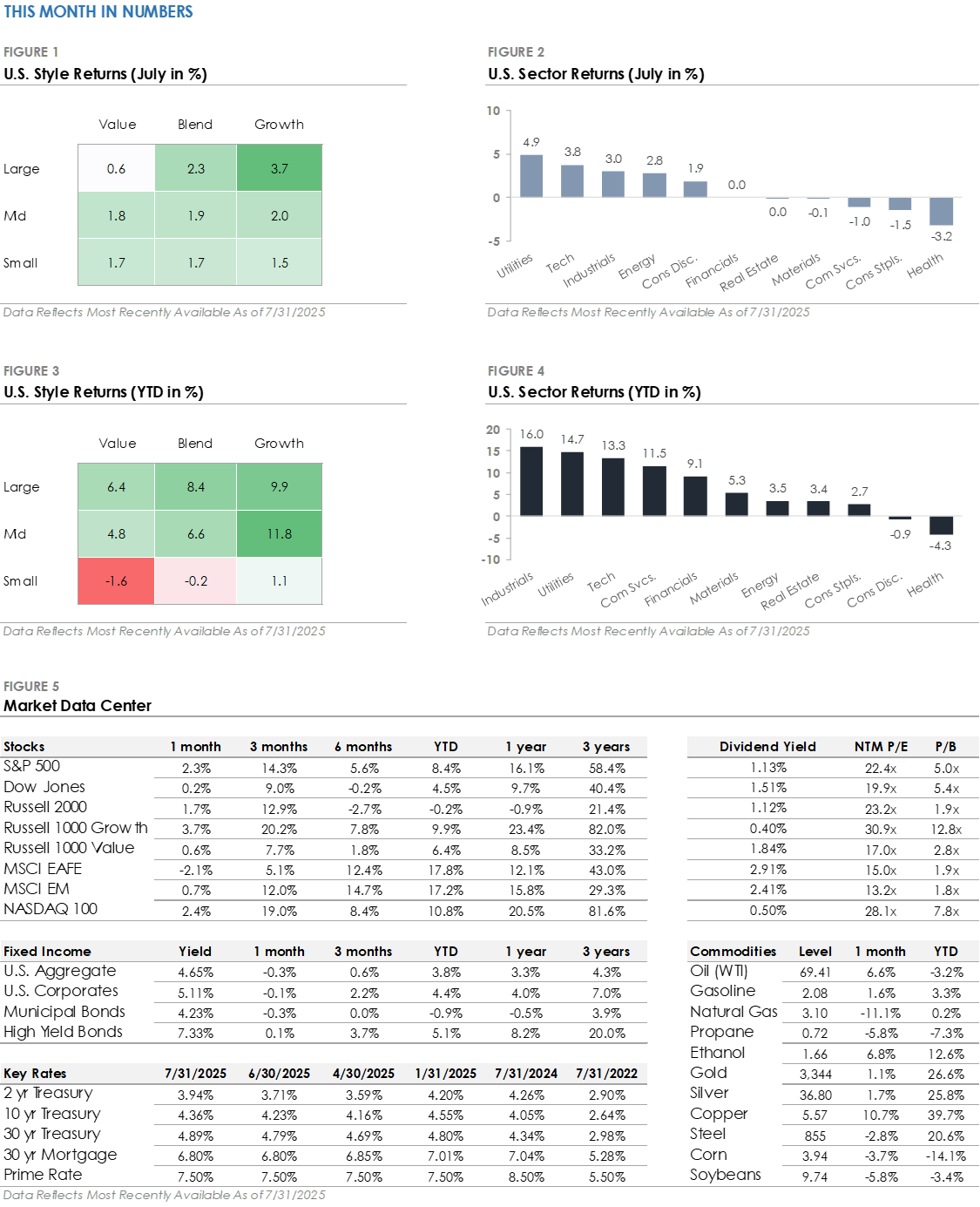
August 2025 - Market Commentary
Date: August 2025
From: Investment Committee
Subject: Market commentary
________________________________________________________________________________
Stocks Trade Higher on Strong Q2 Earnings & Trade Deals
Monthly Market Summary
- The S&P 500 Index rose +2.3% in July, pushing its year-to-date return to +8.4%. Large Cap Growth stocks led with a +3.7% gain, while Large Cap Value gained +0.6%.
- Utilities was the top-performing sector, with the Technology, Industrials, and Energy sectors also outperforming the S&P 500. Defensive sectors underperformed, with Health Care, Consumer Staples, and Communication Services all trading lower.
- Bonds posted a modest loss as Treasury yields rose. The U.S. Bond Aggregate returned -0.3%, with longer maturity Treasury bonds underperforming the index. Corporate bonds outperformed as credit spreads tightened, with investment-grade posting a -0.1% total return and high-yield gaining +0.1%.
- International stocks underperformed the S&P 500 as the U.S. dollar strengthened. Developed Markets fell -2.1%, while Emerging Markets returned +0.7%.
Strong Q2 Earnings & Trade Agreements Send Stocks to All-Time Highs
Stocks climbed to new highs in July, with the S&P 500 and Nasdaq both logging six consecutive record closes late in the month. Investor sentiment improved after better-than-expected Q2 earnings and trade agreements with Japan and the EU, with tariff rates on the deals less severe than feared. Market breadth improved early in the month as smaller companies outperformed the S&P 500. However, by month-end, market leadership was top heavy again, with the Magnificent 7 gaining over +5% after leading AI firms reported strong Q2 earnings. Volatility remained subdued for most of July, and the VIX fell below 15, signaling investor confidence but hinting at potential complacency.
Stock valuations are stretched after the multi-month rally from April’s lows. The S&P 500 trades at over 22x its next 12-month earnings, up from around 18x in early April and well above the 16.8x average since 2000. Today’s extended valuations mean the market is more reliant on earnings growth to fuel gains, which gives companies less room to disappoint. Although the tariff rates in recent deals were lower than feared, the overall effective tariff rate has risen sharply this year. The higher effective tariff rate raises questions about the long-term impact on corporate earnings, consumer demand, and economic growth, as well as the potential near-term impact on inflation.
Interest Rate Cuts Continue to Be Pushed into the Future
After cutting interest rates by a full percentage point in late 2024, the Fed has held interest rates steady through five meetings this year. The pause in the Fed’s rate-cutting cycle reflects two dynamics: inflation progress has stalled, with core CPI stuck near 3.0%, and the labor market remains solid, with unemployment holding near 4%. Policymakers are concerned that tariffs could reignite inflation, and they’ve consistently emphasized the need for patience while they wait for more clarity in the data.
From a markets perspective, rate cut expectations have been repeatedly delayed. An anticipated March cut was pushed to May, then to June, and then to September. The odds of a September cut fell below 50% after the July meeting, with the market pushing the rate cut to October. The market now expects only one rate cut this year, followed by another in January 2026. The takeaway: with no clear signal from the data or the Fed, the market is taking it one meeting at a time.

Firm Disclosures
The information provided herein is for general informational purposes only and is intended for your personal use and should not be circulated to any other person without our permission and any use, distribution, or duplication by anyone other than the recipient is prohibited. No portion of this commentary is to be construed as an offer or solicitation to buy or sell a security, or the rendering of personalized investment advice. The views and strategies described herein may not be suitable for all investors and are subject to investment risks. The content is developed from sources believed to be providing accurate information. The information contained herein should not be relied upon in isolation for the purpose of making any investment decision.
We believe the information contained in this material to be reliable and have sought to take reasonable care in its preparation and conducted reasonable due diligence to ensure the third parties’ performance is not materially inflated or incorrect; however, we do not represent or warrant its accuracy, reliability, or completeness, or accept any liability for any loss or damage (whether direct or indirect) arising out of the use of all or any part of this material. We do not make any representation or warranty regarding any computations, graphs, tables, diagrams, or commentary in this material which are provided for illustration/ reference purposes only. These views, opinions, estimates, and strategies expressed in it constitute our judgement based on current market conditions and are subject to change without notice. Any projected results and risks are based solely on hypothetical examples cited, and actual results and risks will vary depending on specific circumstances. Investors may get back less than they invested, and past performance is not a reliable indicator of future results.
Data which may be found in this document is based on our research and should not be taken as a forecast or an estimate of likely future returns. Any reference to a market index is included for illustrative purposes only, as an index is not a security in which an investment can be made.
Investments involve some sort of risk including potential loss of principal; diversification alone cannot guarantee against loss. Any projected results and risks are based solely on hypothetical examples depicted. Forward-looking statements should not be considered guarantees or predictions of future events. More complete information is available, including product profiles, which discuss risks, benefits, liquidity, and other matters of interest. The value of any investment may fluctuate as a result of market changes. Past performance is no guarantee of future results, and there can be no assurance the investment strategies discussed herein will prove profitable.
All opinions, estimates, investment strategies and views expressed in this document are subject to change without notice information. The recommendations made for your customized portfolio may differ from any asset allocation or strategies outlined in this document. Benchmark Financial does not guarantee the future performance of any portfolio, guarantee any specific level of performance, or guarantee any strategy or overall management will be successful or that the client’s investment objectives will be met.
Benchmark Financial is not a broker dealer and does not offer tax or legal advice. Please consult your tax or legal advisor for assistance regarding your individual situation. Investment Advisory Services offered through Benchmark Financial Wealth Advisors LLC, an SEC Registered Investment Advisor. Insurance services offered through Benchmark Financial Insurance LLC. The Benchmark Financial Wealth Advisors ADV Form 2A, 2B & Form CRS, which describe the services offered, fees charged and any conflicts of interest, are available upon request or online at www.bfllc.com. Additional information about Benchmark Financial and our advisors is also available online at https://adviserinfo.sec.gov/firm/summary/287966.
